Luxury Lifestyle Magazine For The Affluent
AUTOMOBILES
Rebels Wear Black – Rolls-Royce Black Badge
Black has always been associated with rebellion, none-conformist, power, strength, and authority. Such is Rolls-Royce Black Badge’s Heritage.
◙ By D’Affluent Magazine
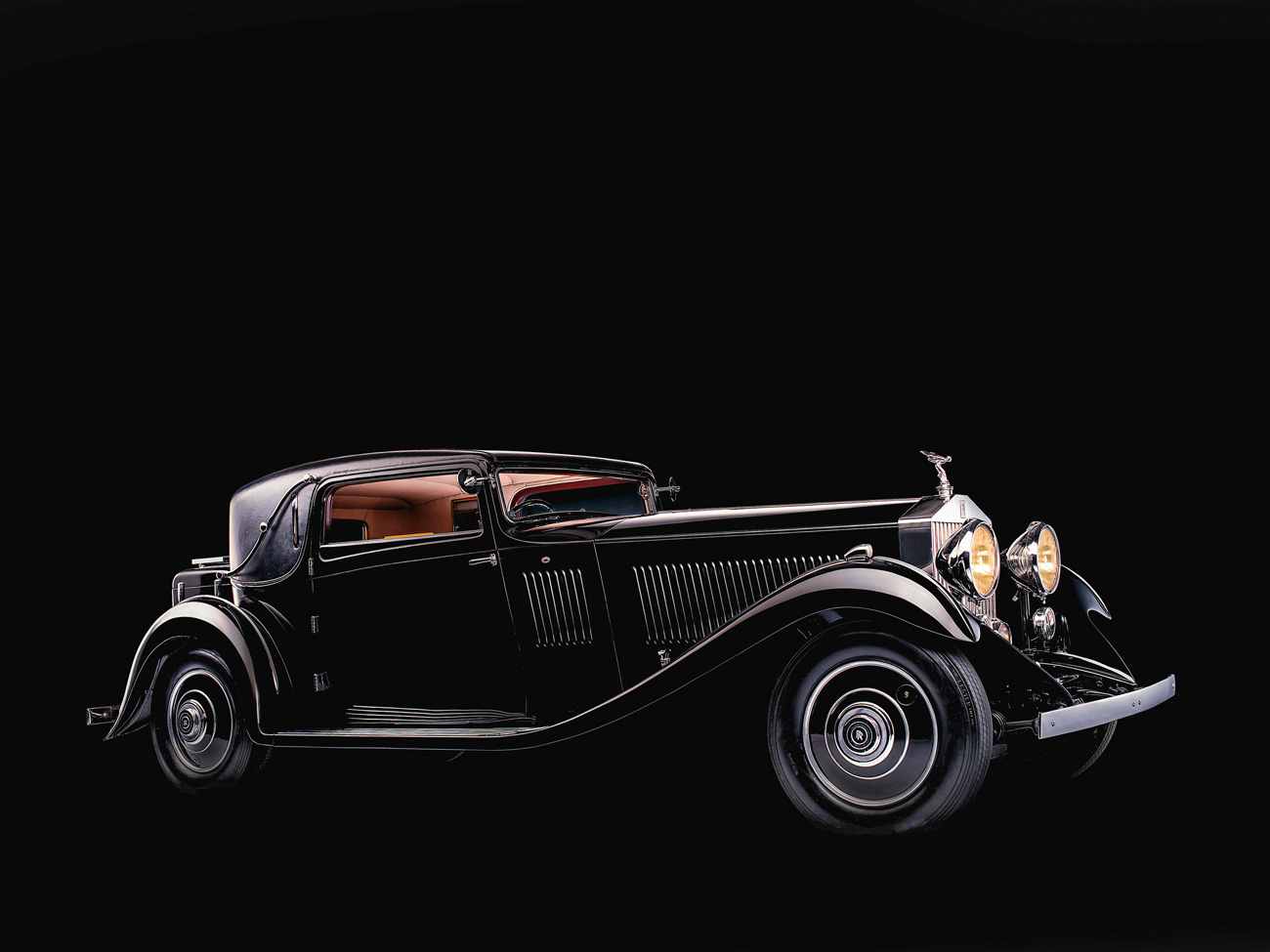
The affluent and prominent in society do not conform to conventions. They push boundaries, go against the grain, and do not bend to society’s mould. They are the rebellious few who are willing to go places where most do not dare go, and thus they achieve what only a handful do. It is from rebellion, the desire for self-expression, the challenging of established convention, individualism, and iconoclasm that Rolls-Royce was born.
The Founders
Henry Royce, one of the founders of Rolls-Royce was one such person. He overcame poverty, deprivation, and did not have formal education to become a world-class engineer; yet he created one of the best and well-known ultra-luxury cars in the world.
The other founder is Cambridge-educated, The Hon. Charles Stewart Rolls, who was born an aristocrat. He could have chosen an easy comfortable life of indolence and privilege, but he decided to get greasy, covered in grime, and indulge in the frequent peril of early motor-racing and aviation, becoming a leading pioneer in both fields.
Both Henry Royce and The Hon. Charles Stewart Rolls were certainly visionaries and courageous dreamers who have taken what most people call the norm, and crushed them; doing what most don’t even dare dream of doing. This is why the Roll-Royce marque has always been the enchanting attraction to those with a rebellious nature, with the urge to lead and never to conform.
“From its very earliest days, Rolls-Royce has attracted free spirits, creative minds and those who seek to challenge established conventions. Though from entirely different backgrounds, our founders both refused to be bound by the norms and expectations of early 20th Century society. It was their courage, vision and willingness to push boundaries that made them who they were – and our company what it is today.
These wonderful historic cars are perfect examples of how that rebellious spirit infuses our brand story, and continues in the modern era with our Black Badge products.”
Torsten Müller-Ötvös, Chief Executive Officer, Rolls-Royce Motor Cars
In 2016, Rolls-Royce launched the Black Badge family of Rolls-Royce motor cars. These cars are the ultimate expression of the spirit of individualism, self-expression, creativity and iconoclasm. Although clients have a vast choice of colours to choose from, till this day black is still the colour of choice since black exudes confidence, strength, power, and authority; all in a bold package of elegance.
Rolls-Royce motor cars in black have been a top choice throughout time. From royalties to celebrities, and of course leaders of industries; many have opted for a black Rolls-Royce. Here are three wonderful examples, spanning more than 30 years. They have a unique place in the marque’s history, and demonstrates how its owner took the all-black theme in a unique and memorable direction.
1933 – Phantom II Continental (94MY)
In 1930, at the personal request of Henry Royce, designer Ivan Evernden penned an experimental Phantom II Continental, designated 26EX, designed specifically for long-distance Continental touring. The car was built with a short chassis and close-coupled four-seat saloon body, with the two spare wheels mounted vertically behind the luggage compartment for optimum weight distribution. The coachwork, erected by Barker & Co, sat on a sub-frame designed to cope with sustained high speeds and powerful braking forces.
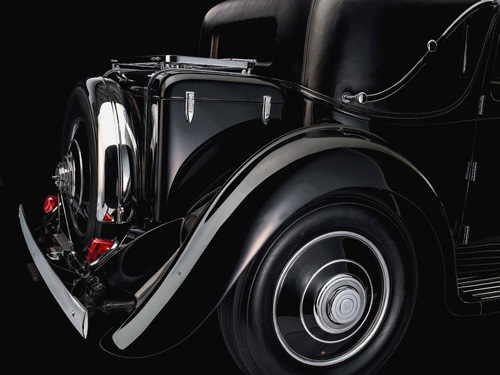
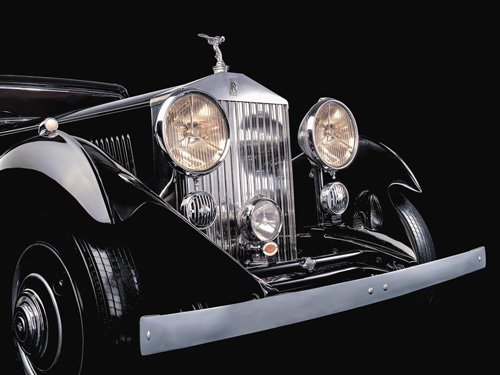
The Phantom II Continental (94MY) is designed to cope with sustained high speeds and powerful breaking forces.
On its first outing, Evernden and Don Carlos de Salamanca drove the car to a concours d’elegance in Biarritz, where it won the Grand Prix d’Honneur. Following this victory, RollsRoyce decided to launch a ‘series’ model with the same mechanical attributes and overall coachwork dimensions as 26EX, giving coachbuilders and owners scope to accommodate their own taste in design.
The first such car, 94MY, built in 1933 for a Mr Samuel Coxhill, has bodywork known as an ‘Owen Fixed Head Coupé’, a specialism of London coachbuilder Gurney Nutting. The adjustable front bucket seats, twin windscreen wipers and flush-fitting direction-indicators behind the side windows were all unusual for the period and intended to make long-distance Continental touring more relaxed.
[ The Spirit of Ecstasy mascot, though supplied, was not fitted, her place taken by the Duke’s own mascot of an eagle in flight… ]
Designer Ivan Evernden declared: “It is the criterion of a good car that one can drive it the whole day long and at the end feel fresh and relaxed enough to enjoy dinner”.
At that time, the vast majority of Rolls-Royce coachwork was finished in either black, or shades of maroon or blue, so dark as to almost seem black. 94MY was ordered in black with “special brown leather, piped in light brown, carpets and headlining to tone, and woodwork to be highly polished veneers”. Combining high performance with superlative comfort and a unique personalised finish, if any 1930s Rolls-Royce could lay claim to embodying the spirit of today’s Black Badge, it is this one.
1960 – Phantom V (5AT30)
The Phantom V was launched in 1959 to replace the venerable Silver Wraith. A much larger car, it was intended primarily for chauffeur-driven use. Amongst them, very few were of limousine design. Most were finished in black, and used either on formal occasions, or for private use by members of the wealthy establishment.
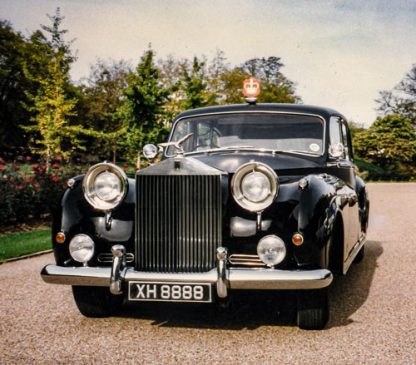
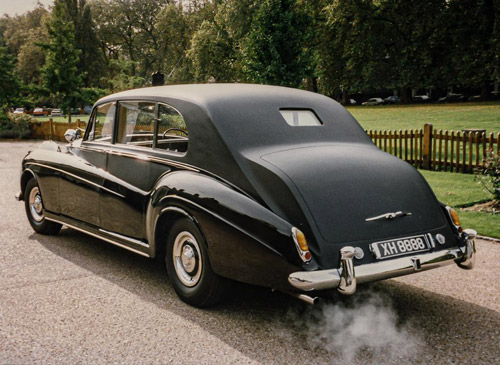
The Rolls-Royce Phantom V (5AT30) owned by HRH The Duke of Gloucester.
One exception was 5AT30. Delivered in September 1960. Its proud owner was HRH The Duke of Gloucester, third son of King George V and Queen Mary, and uncle to HM Queen Elizabeth II. The body was based on coachbuilder James Young’s PV15 design, today regarded as among the most elegant on the Phantom V chassis.
Although about as ‘establishment’ as it’s possible to be, His Royal Highness clearly had strong ideas about what he wanted in his Phantom V. His most obvious departure from the accepted norm is the paint combination of matte black to the horizontal surfaces and gloss black on the vertical planes.
[ The Beatles stormed the world with A Hard Day’s Night. In December, as a gift to himself, John Lennon ordered a brand-new Rolls-Royce Phantom V from R. S. Mead of Maidenhead… ]
Other Bespoke items include a much smaller-than-standard backlight, large foglamps, door-mounted driving mirrors, sliding shutters to the rear windows and two Stephane Grebel spotlights. The front of the car is dominated by Lucas R100 headlamps, in place of the usual faired-in headlights.

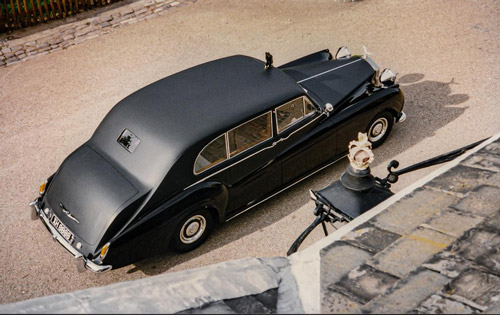
A life saving Rolls-Royce that saved the lives of the Duke and Duchess.
The Spirit of Ecstasy mascot, though supplied, was not fitted, her place taken by the Duke’s own mascot of an eagle in flight. And perhaps for the first time in the marque’s history, the chassis card states that the car was supplied with ‘an umbrella in holder’ – a standard feature on today’s Rolls-Royce motor cars.
On 30 January 1965, the Duke and Duchess were travelling home from Sir Winston Churchill’s funeral when the car skidded off the road and down a shallow embankment, turning over three times and landing on its roof! None of the occupants suffered serious injury; and such was the resilience of the James Young coachwork that 5AT30 was rebuilt and continued to render sterling service to its owner for years to come.
1965 – Phantom V (5VD73)
In 1964, The Beatles stormed the world with A Hard Day’s Night. In December, as a gift to himself, John Lennon ordered a brand-new Rolls-Royce Phantom V from R. S. Mead of Maidenhead. The specification was, as one might expect, highly individual: he wanted the car not just to be black, but black everywhere, inside and out, including all the brightwork that would normally be finished in chromium plate or stainless steel.
The car, built by Mulliner Park Ward, was duly supplied with all-black gloss paintwork, including the wheel discs and bumpers. Only the iconic Pantheon grille and Spirit of Ecstasy mascot retained their conventional chrome finish, at the marque’s insistence.
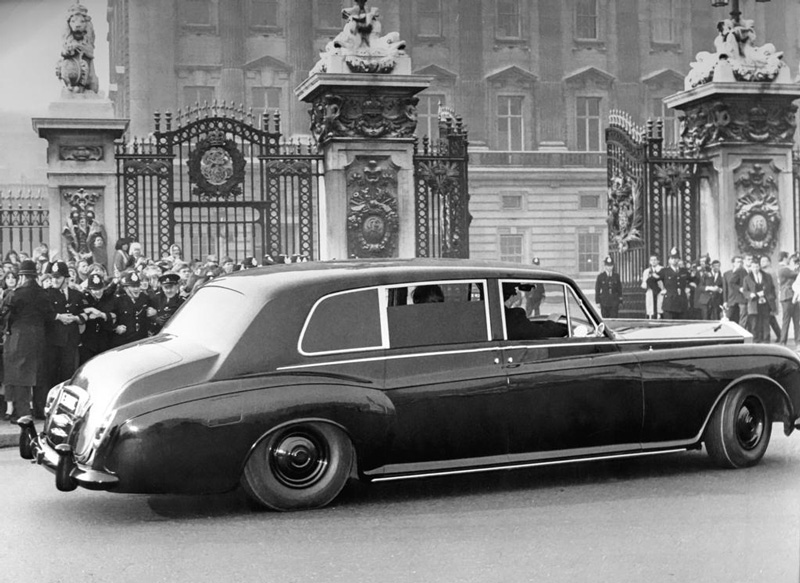
John Lenon’s Rolls-Royce Phantom V 5VD73.
It was also one of the first cars in Britain to have blacked-out windows, made from darkened, reflective Triplex Deeplight glass, 3/16” thick in the rear doors and 3/4” in the rear quarterlights, backlite and division glass – but not, as one might suppose, solely for reasons of privacy. “People think they’ve got black windows to hide. It’s partly that, but it’s also for when you’re coming home late,” Lennon told a Rolling Stone interviewer in 1965. “If it’s daylight when you’re coming home, it’s still dark inside the car – you just shut all the windows and you’re still in the club.”
The interior featured black Bedford cord cloth and black nylon rugs in the rear compartment, and black leather in the front. There were electrical aerials for a radio and a Perdio Portarma television set, and a seven-piece set of black fitted luggage. Legend has it that the car also had a record player, radio telephone, fridge, writing table and red mood-lighting: this remains unproven, but could easily have been later additions; likewise, a rear seat that, according to many accounts, could be converted into a pull-out bed.
Such bold, imaginative and unconventional choices are, of course, entirely consistent with Lennon’s status as one of the 20th Century’s greatest cultural innovators.
Later, the car was repainted in a game-changing, vivid psychedelic electric yellow, embellished with flowers, Romany scrolls and signs of the zodiac. It is wholly unique, indelibly identified with its owner and, in certain quarters, generated its share of controversy – perhaps the perfect encapsulation of the Black Badge spirit.
Rolls-Royce motor cars has certainly come a long way since, and have shared many a journey with the many affluent and prominent people in society; those who make things happen, break barriers, and even bend the world into what it is today. That unquenchable spirit continues to be expressed in new and dynamic ways through the ever-evolving Rolls-Royce Black Badge family.
*Photos and information courtesy of Rolls-Royce Motor Cars
Luxury Lifestyle Magazine For The Affluent

